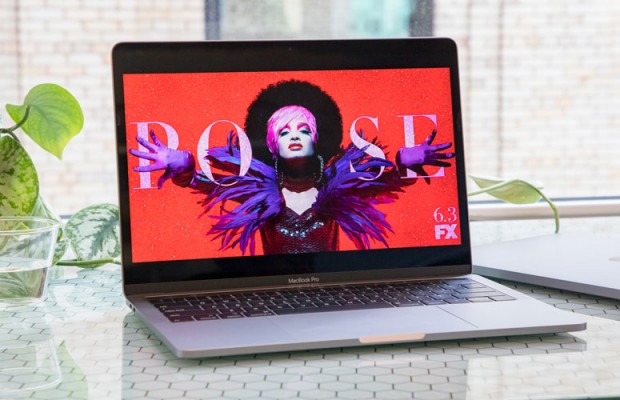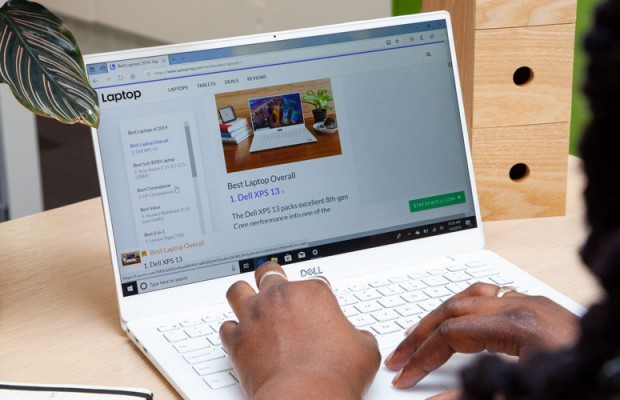Dell XPS 13 vs. MacBook Pro: Which Laptop Wins?
Hatfield-McCoy, Freddy versus Jason, da Vinci and Michelangelo — and in the laptop world, XPS 13 versus MacBook Pro. Some of the great rivalries of history include this heavyweight competition between Apple's and Dell's flagship devices, which rages on to this day. While the MacBook Pro was arguably the better machine at the start of the decade, the XPS 13 has turned a corner in recent years, outperforming the MacBook Pro in the past few matchups.
This year, the XPS 13 is better than ever thanks to some clever improvements made to its design and an upgrade to Intel's Whiskey Lake chips. But it faces renewed competition from the latest 13-inch MacBook Pro, which received a quieter keyboard and upgraded components. So, which of these laptops takes the crown in 2019? Let's find out.
Dell XPS 13 (2019) vs. MacBook Pro (2018): Specs Compared
| Row 0 - Cell 0 | Dell XPS 13 (2019) | MacBook Pro (2018) |
| Starting Price (as configured) | $900 ($2,449) | $1,799 ($2,499) |
| Colors | Frost White/Silver; Rose Gold | Silver, Space Gray |
| Display | 13.3-inch, 4K touch screen (or 1080p non-touch) | 13.3-inch, 2560 x 1600-pixel |
| CPU | Intel Core i7-8565U | Intel Core i7 (8th Gen) |
| RAM | 16GB | 8GB |
| SSD | 1TB | 256GB |
| Key Travel | 1 mm | 0.6 mm |
| Ports | 2 Thunderbolt 3, USB-C, microSD card, headphone | 4 Thunderbolt 3, headphone |
| Webcam | 720p | 720p |
| Size | 11.9 x 7.8 x 0.5 inches | 12.0 x 8.4 x 0.6 inches |
| Geekbench 4 | 14,936 | 17,348 |
| Battery Life (hrs:mins) | TBD (1080p)7:50 (4K) | 8:43 |
| Weight | 2.7 pounds | 3 pounds |
Design
While neither laptop received a major design overhaul from its predecessor, Dell deserves credit for mixing things up a bit. The XPS 13 has a familiar look and feel but the lid now comes in Frost Silver, a snazzy soft, off-white/silver finish. Combine the new color option with last year's snow- white glass-fiber woven deck, and the new XPS 13 is one alluring package.
As striking as the new XPS 13 looks, my favorite thing about its design has nothing to do with aesthetics. Rather, the best change Dell made to the new model was moving the webcam back to its rightful position above the display. Now, the gorgeous chassis we've praised year after year is uncompromised.
As they say: If it ain't broke, don't fix it. Apple took a conservative approach with the MacBook Pro, keeping the chassis of the new model identical to its predecessor. Although it's hard to find fault with the laptop's design, the MacBook Pro's signature look is growing stale, especially when compared with the sleeker and sexier XPS 13.
Sign up to receive The Snapshot, a free special dispatch from Laptop Mag, in your inbox.
At 11.9 x 7.8 x 0.5 inches and 2.7 pounds, the Dell XPS 13 is considerably more compact and lighter than the 12 x 8.4 x 0.6-inch, 3-pound MacBook Pro.
Winner: XPS 13
Ports
Be prepared to live a life of dongle with these laptops. Their slim chassis can't support a lot of connections, so you're limited to USB-C ports. The XPS 13 gives you a microSD card slot to go along with a pair of Thunderbolt 3 ports and a USB-C input, while the MacBook Pro has a four-of-a-kind hand of Thunderbolt 3 ports. Both computers come with a headphone jack.
Winner: Draw
Display
Whether you're binge-watching a Netflix show or simply browsing the web, the content you view on the XPS 13 and MacBook Pro will look fantastic.
The 13.3-inch, 4K touch-screen display we tested on the XPS 13 produces a crystal-clear image with vivid colors. The panel covers an impressive 119 percent of the sRGB color gamut and reaches a maximum brightness of 375 nits.
Those results are comparable to the 13.3-inch, 2560 x 1600-pixel Retina display on the MacBook Pro. While the screen on the MacBook Pro isn't quite as sharp as the 4K XPS 13, it is notably brighter, reaching 439 nits. The MacBook Pro (119 percent) has the same range of colors as the XPS 13.
The XPS 13 has an edge over the MacBook Pro thanks to its captivating bezelless design and touch support, but the MacBook Pro features Apple's True Tone feature, which changes the white balance based on the color temperature of your environment.
MORE: Laptops with the Best Display Brightness
The XPS 13 can also be configured with a standard 1080p display. We don't expect it to be as impressive as the 4K screen, but we'll know for sure once we've had a chance to test that version.
Winner: Draw
Keyboard and Touchpad
Despite having only 1 millimeter of key travel, the XPS 13's keyboard is fairly comfortable to type on. While the keys are a bit cramped on the compact deck, they feel clicky thanks to their 63 grams of actuation force (60 to 70 grams is our sweet spot). Better yet, I never felt the discomfort caused by bottoming out.
The same can't be said about the MacBook Pro's keyboard. With just 0.6 mm of travel, the keys feel stiff and rigid. On the bright side, the 61 grams of actuation force allowed me to maintain a good typing pace, and the new keyboard is quieter and more reliable than last year's disaster.
When typing on the XPS 13, I reached 116 words per minute with a 94 percent accuracy rate on the 10fastfingers.com typing test. I typed slightly faster on the MacBook Pro, averaging 119 wpm at a 6 percent error rate.
MORE: Hey, Apple: Fix Your Crappy Keyboards or I'm Switching to Windows
The touchpads on both laptops are fast and responsive, but I prefer the much larger surface on the MacBook Pro (5.3 x 3.3 inches) than the confined touchpad on the XPS 13 (4.1 x 2.3 inches).
Winner: XPS 13
Performance
The latest Whiskey Lake CPUs give the XPS 13 a nice performance boost, but the ultrabook still can't keep up with the MacBook Pro.
Our review unit — equipped with an Intel Core i7-8565U CPU and 16GB of RAM — scored a 14,936 on the Geekbench 4 overall performance test. Although that's significantly higher than the premium laptop average (13,354), the XPS gets nowhere near the similarly specced MacBook Pro's (8th Gen Core i7 CPU, 16GB of RAM) score of 17,348.
The XPS 13 avenged its defeat in our Excel Macro Test, which matches 65,000 names with their corresponding addresses. The new XPS 13 needed 1 minute and 10 seconds to complete the test, while the MacBook Pro took 1 minute and 16 seconds. Both times are faster than the category average (1:31).
The MacBook Pro pulls away from the XPS 13 (and the rest of the competition) because of its ridiculously fast 256GB NVMe SSD. The MacBook Pro needed only 2 seconds to duplicate 4.97GB of mixed-media files, equating to an unthinkable transfer rate of 2,519 megabytes per second. The 1TB PCIe SSD in the XPS 13 is quick, but its file transfer rate of 565 MBps doesn't come close to the MacBook's record speed.
MORE: Best Hard Drive Speed
In our Handbrake test, the MacBook Pro needed only 14 minutes and 47 seconds to convert a 4K video into 1080p resolution, whereas the XPS 13 completed the same task in 19 minutes and 20 seconds.
Winner: MacBook Pro
Battery Life
We expect around 10 hours of battery life in a flagship ultrabook. Sadly, neither of these laptops reached that target.
The XPS 13 powered down after just 7 hours and 50 minutes on our Laptop Mag Battery Test (continuous web surfing over Wi-Fi at 150 nits of display brightness). That's not a terrible result for a 4K laptop but it falls short of last year's equivalent model (8:53) and some of the competition.
MORE: Longest Battery Life Laptops
The MacBook Pro endured for 8 hours and 43 minutes under the same testing conditions. Again, that's not a bad result, but competing laptops, like the Huawei MateBook X Pro (9:55) and the Microsoft Surface Book 2 (9:10), last longer on a charge.
The MacBook Pro wins this round by a slim margin, at least until we can test the 1080p model of the XPS 13.
Winner: MacBook Pro
Value and Price
The XPS 13 is a lot cheaper than the MacBook Pro. And you get more configuration options than what Apple offers.
On the low-end, an $899 base model comes with an FHD display along with an Intel Core i3 CPU, 4GB of RAM, a 128GB SSD and Intel UHD 620 graphics. Upgrading to our minimum recommended configuration — 1080p display, 8GB of RAM, 256GB SSD — raises the price to $1,185. Power users can spend another $245 on a Core i7 CPU.
If you want the 4K touch-screen model, you'll need to save up at least $1,822, but at least that nets you a Core i7 CPU, 16GB of RAM and a 256GB hard drive. Our decked-out unit had a 4K display, a Core i7 CPU, 16GB of RAM and a 1TB SSD for $2,449.
The MacBook Pro is exorbitantly priced. If you want the updated model, you'll need to spend a minimum of $1,799, which gets you only a 13.3-inch, 2560 x 1600-pixel display (there is no 4K option), a Core i5 CPU, 8GB of RAM and a 256GB SSD. From there, you can double the memory to 16GB for another $200 or upgrade to a Core i7 for an additional $300. The MacBook Pro can be configured with up to 2TB of storage but that will cost you an extra $1,400.
Winner: XPS 13
Overall Winner: Dell XPS 13
| Row 0 - Cell 0 | Dell XPS 13 (2019 | MacBook Pro (2018) |
| Design (10) | 10 | 8 |
| Ports (10) | 5 | 5 |
| Display (15) | 12 | 12 |
| Keyboard/Touchpad (15) | 10 | 8 |
| Performance | 16 | 19 |
| Battery Life (20) | 14 | 15 |
| Value (10) | 8 | 4 |
| Overall (100) | 75 | 71 |
The Dell XPS 13 is a better laptop than the MacBook Pro for a couple of reasons. Namely, the Dell laptop has a thinner, sleeker (and frankly, sexier) design than the MacBook Pro, and its keyboard is more comfortable to type on. If you simply need the most powerful laptop on the market (or prefer macOS over Windows 10), then the MacBook Pro remains the best choice. Still, its blazing speed doesn't make it the better overall device.
Perhaps if the MacBook Pro wasn't so expensive, this showdown would have ended differently. But when it comes down to it, the XPS 13 simply offers more for less.
Credit: Laptop Mag
Phillip Tracy is the assistant managing editor at Laptop Mag where he reviews laptops, phones and other gadgets while covering the latest industry news. After graduating with a journalism degree from the University of Texas at Austin, Phillip became a tech reporter at the Daily Dot. There, he wrote reviews for a range of gadgets and covered everything from social media trends to cybersecurity. Prior to that, he wrote for RCR Wireless News covering 5G and IoT. When he's not tinkering with devices, you can find Phillip playing video games, reading, traveling or watching soccer.











